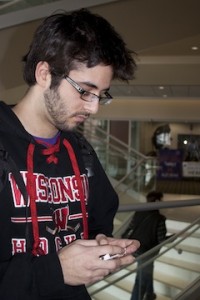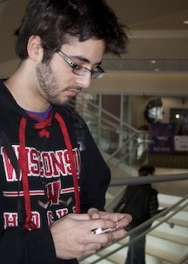Technology may be making a liar’s job easier.
Research published by The Los Angeles Times suggests it’s easier to lie in a text message versus face-to-face conversation.

St. Thomas psychology professor Gary Starr said he was not surprised by the findings.
“When you’re face-to-face, there’s an underlying assumption that there is going to be more genuineness,” Starr said. “If someone is lying to you, you feel you should be able to tell because of the extra signals you’re able to identify… their intonation, their mannerisms or the way their eyes look.”
The study consisted of 140 college students separated into pairs. One student was assigned to role play as a stockbroker, and the other acted as a potential buyer. Personal incentives were offered to stockbrokers who sold the most stock, and the brokers were informed that the hypothetical stock would lose at least 50 percent of its value within the week.
The research found that stockbrokers who communicated with their counterpart via text messages consistently lied or evaded answers when asked questions about the stock’s value, more so than those engaged in face-to-face conversation.
The study also claimed that people who had been deceived in a text message were less offended than those in physical contact.
Starr said that similar studies had been conducted in a military context by social psychologist Stanley Milgram in the 1970s.
Milgram’s studies found that subjects were more likely to follow orders from an authority figure if the psychological distance between subject and the target was increased, even if the orders resulted in mass deaths.
“Militarily, it’s easier to push a button and kill someone than in hand-to-hand combat,” Starr explained. “It’s almost as if it’s more acceptable to stab someone in the back than in the chest.”
Starr said the idea of psychological distance relates to text messaging.
“Texting is so limited and so devoid of context that it makes it possible to get away with anything,” he said.
Several St. Thomas students admitted to the ease of lying via text message, most attributing it to the lack of physical indicators.
“There’s no face-to-face contact, so you don’t have to approach this person,” senior Peter Nyborg said. “That phone number is your alias, and it’s a way to stand behind in the shadows.”
Senior Phylicia Short agrees that facial expressions betray a liar, but she has become more apt at catching dishonesty when not communicating directly with a person.
“I think you can tell you’re being lied to because it doesn’t feel right when you’re reading it,” she said. “It’s easier to catch people lying with technology.”
Students were not shocked that text message correspondence promoted dishonesty, but it did surprise some students to learn that pairs connected by a web camera were the least likely to lie.
Freshman Riley Kaniewski said he anticipated different results.
“That’s surprising to me,” Kaniewski said. “Lying in texting isn’t surprising because you’re not intimidated by the other person. I’d imagine that lying over a video chat would be a halfway mark because you’re face-to-face without being face-to-face.”
However, Starr said people would probably be more conscious about conveying true information over video chats because of the ability to record the conversation.
“Some people are more conscious of what they write in emails because there’s no assumption that it’s really private at all,” Starr said. He said the same is true with video content.
Nyborg said he did not expect video communication to be the “most honest” but admitted it made sense when he compared it to other platforms.
“Text messages are straight text; it’s just words. Over video, you’re adding voice and you’re adding an image. It’s not as easy to lie behind that,” Nyborg said. “A lie is not only sold in the voice, but it’s also sold in the facial expression.”
With all things considered, Starr said that the research may be true in the context of a business exchange but not necessarily in a social relationship.
“In a business situation… it’s going to be all about money. There’s an underlying assumption with a business person that the end goal is money,” he said. “The results might be different if the conversation was between two significant others.”
Anastasia Straley can be reached at stra0669@stthomas.edu.

